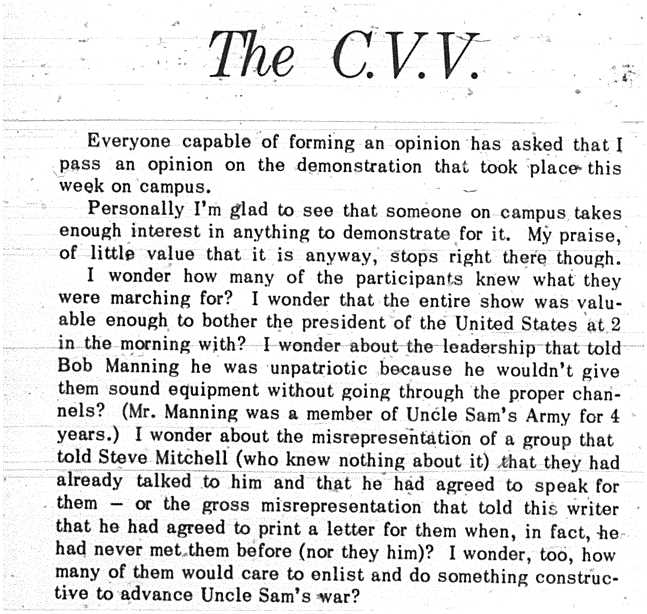Vietnam Protests
Beginning c. 1965
When many think of protests during the 1960s, they think of the anti-Vietnam protests on college campuses throughout the country. At Northern, however, many students supported the war effort and were against the protesters. In part, this could be due to the nature of NMU—it was a small, largely rural school with many older students. One student of the time said in an oral history interview that the AmVets club “had a lot of swing on campus” even during Vietnam. The relative proportions of pro- and anti-Vietnam students is not known, and it probably changed throughout the course of the war. Some sources suggest that there were still more students who were pro-war than anti-war. However, there are just as many that suggest the opposite.
In October of 1965, the first war protests occurred at Northern. Dr. Ellsworth “Dutch” Barnard, a popular and radical English professor, wrote a letter to the Northern News supporting the Vietnam War protests which had begun nationwide. This letter raised quite a bit of ire among some students who supported the war.
A few weeks later, a group of six people calling themselves the “Committee for Victory in Vietnam” organized a sudden demonstration in support of President Johnson. Over 200 students attended the rally which had, according to the Northern News, “the backing of President Harden, Dean Niemi, the City Commission, the Chief of Police, and most of the students and persons affiliated with Northern”. The committee also attempted to call President Nixon at 2 in the morning (the article above says 2 P.M.; however, later articles in the Northern News say 2 A.M., so it is unclear which is accurate) to inform him of their support. However, “[a]s the President was sleeping at the time, a message was left with his aide stating that NMU was staging a demonstration in support of his policy in Vietnam”. The article again commented that “the majority of students on campus…supported the demonstration”.
In the weeks following the protest, it became clear that the 200 students who had attended the demonstration were not, in fact, the majority. One woman called the CVV because she “wanted to determine that the CVV was a campus organization. My inquiry elicited the response that they represented the ‘American Students’. However, it developed that the ‘American Students’ is not an organization but rather a term that is meant to cover all of us. It is a known fact, however, that there are students legitimately concerned with our policy in Vietnam who are in disagreement with the position of this group”. The editor of the student newspaper wondered “how many of them [the CVV] would care to enlist and do something constructive to advance Uncle Sam’s war” and noted that the committee had attempted to force people into helping them with their demonstration by bullying them with claims of their unpatriotism. He also denied the allegations of the CVV that they had contacted him about publishing an article supporting their protest.
The CVV responded that the editor was presenting a biased and untrue statement of the facts. However, they themselves claimed that twelve hundred students attended the demonstration when more objective local news reporters recorded two hundred and fifty protestors. Some asked whether protesting against the war was “some sort of treason.” The CVV further claimed that opponents of the war were ready to send “blood, medical supplies, and even themselves to the Viet Cong, America’s enemy”.

